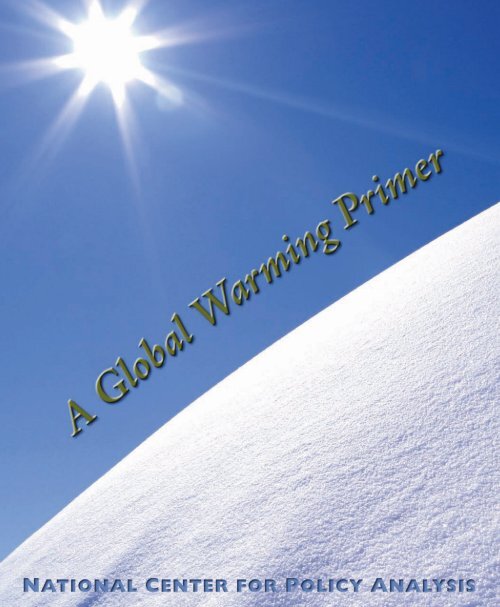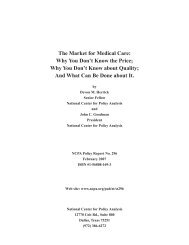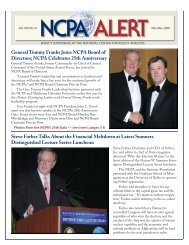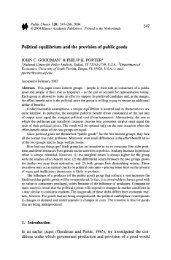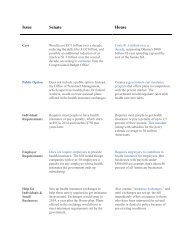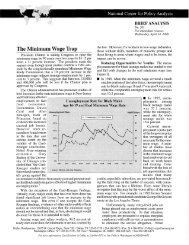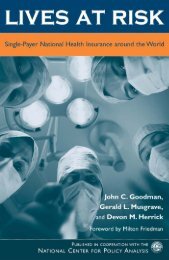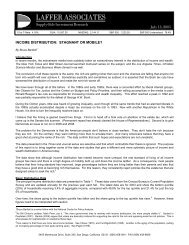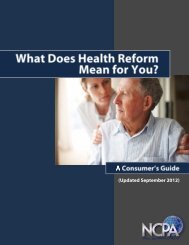Global Warming Primer - National Center for Policy Analysis
Global Warming Primer - National Center for Policy Analysis
Global Warming Primer - National Center for Policy Analysis
Create successful ePaper yourself
Turn your PDF publications into a flip-book with our unique Google optimized e-Paper software.
© 2007 <strong>National</strong> <strong>Center</strong> <strong>for</strong> <strong>Policy</strong> <strong>Analysis</strong><br />
ISBN 1-56808-193-6<br />
Disclaimer: This primer is based on a review of available scientific research. The NCPA<br />
received no money and no input from any private company or government agency.
A <strong>Global</strong> <strong>Warming</strong> <strong>Primer</strong><br />
A <strong>Global</strong> <strong>Warming</strong> <strong>Primer</strong><br />
The purpose of this primer is to explore some of the main scientific, economic and<br />
political issues surrounding the topic of global warming.<br />
Table of Contents<br />
Part I: A Brief History of <strong>Global</strong> <strong>Warming</strong> . . . . . . . . . . . . . . . . . . . . . . . . . .4<br />
Part II: Consequences of Recent <strong>Warming</strong> . . . . . . . . . . . . . . . . . . . . . . . . . .23<br />
Part III: Responses to Future <strong>Warming</strong>..............................31<br />
Source List . . . . . . . . . . . . . . . . . . . . . . . . . . . . . . . . . . . . . . . . . . . . . . . . . . . . . . .38<br />
<strong>National</strong> <strong>Center</strong> <strong>for</strong> <strong>Policy</strong> <strong>Analysis</strong><br />
3
A <strong>Global</strong> <strong>Warming</strong> <strong>Primer</strong><br />
Part I: A Brief History of <strong>Global</strong> <strong>Warming</strong><br />
Greenhouse gases are a small part of the Earth’s atmosphere. However, they are critical to<br />
making the planet habitable—keeping the Earth from being a freezing rock in space like Mars.<br />
4<br />
Human activities, primarily the burning of fossil fuels <strong>for</strong> energy and de<strong>for</strong>estation, have<br />
contributed to an increase in greenhouse gases and many scientists believe this has caused the<br />
present warming trend.<br />
<strong>National</strong> <strong>Center</strong> <strong>for</strong> <strong>Policy</strong> <strong>Analysis</strong>
Part I: A Brief History of <strong>Global</strong> <strong>Warming</strong><br />
Greenhouse gases make up no more than 2 percent of the<br />
Earth’s atmosphere.<br />
How Much of the Atmosphere Is Greenhouse Gases?<br />
<strong>National</strong> <strong>Center</strong> <strong>for</strong> <strong>Policy</strong> <strong>Analysis</strong><br />
5
A <strong>Global</strong> <strong>Warming</strong> <strong>Primer</strong><br />
What Are the Greenhouse Gases<br />
in the Atmosphere?<br />
CO 2<br />
is a naturally occurring greenhouse gas. Humans and other animals<br />
emit CO 2<br />
into the atmosphere when they exhale, and plants absorb it.<br />
CO 2<br />
and other trace gases are only 5 percent of the greenhouse gases in<br />
the atmosphere. Water vapor makes up the other 95 percent.<br />
6<br />
<strong>National</strong> <strong>Center</strong> <strong>for</strong> <strong>Policy</strong> <strong>Analysis</strong>
Part I: A Brief History of <strong>Global</strong> <strong>Warming</strong><br />
Humans contribute approximately 3.4 percent of annual CO 2<br />
emissions. However, small increases in annual CO 2<br />
emissions,<br />
whether from humans or any other source, can lead to a large CO 2<br />
accumulation over time because CO 2<br />
molecules can remain in the<br />
atmosphere <strong>for</strong> more than a century.<br />
Where Do CO 2 Emissions Come From?<br />
<strong>National</strong> <strong>Center</strong> <strong>for</strong> <strong>Policy</strong> <strong>Analysis</strong><br />
7
A <strong>Global</strong> <strong>Warming</strong> <strong>Primer</strong><br />
What Is the Human Share of the<br />
Greenhouse Effect?<br />
Humanity is responsible <strong>for</strong> about one-quarter of 1 percent<br />
of the greenhouse effect.<br />
8<br />
<strong>National</strong> <strong>Center</strong> <strong>for</strong> <strong>Policy</strong> <strong>Analysis</strong>
Part I: A Brief History of <strong>Global</strong> <strong>Warming</strong><br />
There was an explosion of life <strong>for</strong>ms 550 million years ago (Cambrian Period),<br />
when CO 2<br />
levels were 18 times higher than today. During the Jurassic Period,<br />
when the dinosaurs roamed the Earth, CO 2<br />
levels were as much as nine times<br />
higher than today.<br />
How Have CO 2 Levels Changed over<br />
the Past 600 Million Years?<br />
<strong>National</strong> <strong>Center</strong> <strong>for</strong> <strong>Policy</strong> <strong>Analysis</strong><br />
9
A <strong>Global</strong> <strong>Warming</strong> <strong>Primer</strong><br />
How Has the Earth’s Temperature Changed<br />
over the Past 600 Million Years?<br />
During the time dinosaurs roamed the Earth, the average<br />
temperature was about 18°F (10°C) warmer than it is today.<br />
10<br />
<strong>National</strong> <strong>Center</strong> <strong>for</strong> <strong>Policy</strong> <strong>Analysis</strong>
Part I: A Brief History of <strong>Global</strong> <strong>Warming</strong><br />
Over long periods of time, there is no close relationship between<br />
CO 2<br />
levels and temperature.<br />
Is There a Relationship Between CO 2<br />
and <strong>Global</strong> Temperature over the Earth’s History?<br />
<strong>National</strong> <strong>Center</strong> <strong>for</strong> <strong>Policy</strong> <strong>Analysis</strong><br />
11
A <strong>Global</strong> <strong>Warming</strong> <strong>Primer</strong><br />
How Has the Earth’s Temperature Changed<br />
over the Past 400,000 Years?<br />
Over the past 400,000 years, there has been a series of ice ages lasting 100,000<br />
years, on the average, interrupted by warm periods lasting about 10,000<br />
years. During ice ages, the temperature drops by as much as 21°F, sea levels<br />
fall dramatically, glaciers expand and most living things are <strong>for</strong>ced to migrate<br />
toward the equator. During periods of relative warmth, sea levels rise and<br />
glaciers retreat. We are currently at the tail end of a warm period.<br />
12<br />
<strong>National</strong> <strong>Center</strong> <strong>for</strong> <strong>Policy</strong> <strong>Analysis</strong>
Part I: A Brief History of <strong>Global</strong> <strong>Warming</strong><br />
For the past 400,000 years, temperature and CO 2<br />
levels have varied<br />
together. However, the Earth’s temperature has consistently risen and<br />
fallen hundreds of years prior to increases and declines in CO 2<br />
levels.<br />
What Is the Relationship between Temperature and<br />
CO 2 over the Past 400,000 Years?<br />
<strong>National</strong> <strong>Center</strong> <strong>for</strong> <strong>Policy</strong> <strong>Analysis</strong><br />
13
A <strong>Global</strong> <strong>Warming</strong> <strong>Primer</strong><br />
How Have Temperatures Changed<br />
over the Past 3,000 Years?<br />
During Roman and medieval times, the Earth was as warm as or warmer than<br />
it is today. A “little ice age” began in the 1300s and ended in the mid-1800s.<br />
14<br />
<strong>National</strong> <strong>Center</strong> <strong>for</strong> <strong>Policy</strong> <strong>Analysis</strong>
Part I: A Brief History of <strong>Global</strong> <strong>Warming</strong><br />
CO 2<br />
levels have been fairly constant <strong>for</strong> the last 10,000 years. Largely due to<br />
human activities, including the burning of fossil fuels and de<strong>for</strong>estation, CO 2<br />
levels have risen approximately 35 percent since the beginning of the industrial<br />
revolution, with more than 80 percent of that rise occurring since 1950.<br />
How Much Have CO 2 Levels Changed<br />
in Recent Times?<br />
<strong>National</strong> <strong>Center</strong> <strong>for</strong> <strong>Policy</strong> <strong>Analysis</strong><br />
15
A <strong>Global</strong> <strong>Warming</strong> <strong>Primer</strong><br />
How Much of the Present <strong>Warming</strong> Was Caused<br />
by Increasing Levels of CO 2 ?<br />
The Earth’s average temperature has risen a little less than one degree<br />
Celsius over the past century. Although almost half of this warming<br />
occurred be<strong>for</strong>e 1940, greenhouse gas emissions began to rise<br />
substantially only after the 1950s.<br />
16<br />
<strong>National</strong> <strong>Center</strong> <strong>for</strong> <strong>Policy</strong> <strong>Analysis</strong>
Part I: A Brief History of <strong>Global</strong> <strong>Warming</strong><br />
The United States emits more CO 2<br />
per person than almost any<br />
other developed country.<br />
How Do America’s CO 2 Emissions Compare<br />
to Other Developed Countries?<br />
<strong>National</strong> <strong>Center</strong> <strong>for</strong> <strong>Policy</strong> <strong>Analysis</strong><br />
17
A <strong>Global</strong> <strong>Warming</strong> <strong>Primer</strong><br />
How Have CO 2 Emissions Changed<br />
in Recent Years?<br />
The United States has slowed the growth of its emissions far more<br />
than the European Union—despite larger population growth and<br />
higher economic growth.<br />
18<br />
<strong>National</strong> <strong>Center</strong> <strong>for</strong> <strong>Policy</strong> <strong>Analysis</strong>
Part I: A Brief History of <strong>Global</strong> <strong>Warming</strong><br />
Most reports focus on gross CO 2<br />
emissions. However, as much as 40<br />
percent of U.S. human CO 2<br />
emissions are reabsorbed, primarily by<br />
vegetation.<br />
How Much CO 2 Does<br />
the United States Really Emit?<br />
<strong>National</strong> <strong>Center</strong> <strong>for</strong> <strong>Policy</strong> <strong>Analysis</strong><br />
19
A <strong>Global</strong> <strong>Warming</strong> <strong>Primer</strong><br />
How Much Do We Know about the Causes<br />
of <strong>Global</strong> Temperature Change?<br />
We know very little<br />
about 75 percent of the<br />
factors that scientists<br />
believe influence global<br />
temperature.<br />
20<br />
<strong>National</strong> <strong>Center</strong> <strong>for</strong> <strong>Policy</strong> <strong>Analysis</strong>
Part I: A Brief History of <strong>Global</strong> <strong>Warming</strong><br />
There are many climate change models used to predict global warming.<br />
This graph shows how the mid-range estimates of those models have<br />
changed over time.<br />
Predicted Temperature Increases<br />
6 o C<br />
5 o C<br />
1990 prediction<br />
4 o C<br />
3 o C<br />
2 o C<br />
2001 prediction<br />
2007 prediction<br />
1995 prediction<br />
1 o C<br />
0 o C<br />
Year<br />
1990 2050 2100<br />
How Good Are Climate Models at<br />
Predicting <strong>Global</strong> <strong>Warming</strong>?<br />
<strong>National</strong> <strong>Center</strong> <strong>for</strong> <strong>Policy</strong> <strong>Analysis</strong><br />
21
A <strong>Global</strong> <strong>Warming</strong> <strong>Primer</strong><br />
Do Scientists Agree That<br />
Humans Are Causing the Present <strong>Warming</strong>?<br />
Approximately 56 percent of climate scientists worldwide believe<br />
humans are the cause of global warming.<br />
22<br />
<strong>National</strong> <strong>Center</strong> <strong>for</strong> <strong>Policy</strong> <strong>Analysis</strong>
Part II: Consequences of Recent <strong>Warming</strong><br />
Part II: Consequences of Recent <strong>Warming</strong><br />
Many scientists worry that global warming will cause droughts, floods, hurricanes of<br />
greater intensity, coastal flooding and the extinction of species that cannot adapt to<br />
change. So far, these effects are not evident.<br />
<strong>National</strong> <strong>Center</strong> <strong>for</strong> <strong>Policy</strong> <strong>Analysis</strong><br />
23
A <strong>Global</strong> <strong>Warming</strong> <strong>Primer</strong><br />
Is <strong>Global</strong> <strong>Warming</strong> Causing Rising Sea Levels?<br />
Sea levels have risen since the Earth began to come out of the<br />
last ice age. However, the rate of sea level rise since 1961, less<br />
than two-sixteenths of an inch annually, is far lower than the<br />
historic average.<br />
24<br />
<strong>National</strong> <strong>Center</strong> <strong>for</strong> <strong>Policy</strong> <strong>Analysis</strong>
Part II: Consequences of Recent <strong>Warming</strong><br />
While ice has melted at the edges and thinned in other locations on Greenland and<br />
Antarctica, much of their interiors have thickened due in part to increased annual<br />
snowpack. Estimates of the net effect range from ice gains to ice losses. At most, ice<br />
loss in the two regions since 1993 has contributed 0.8 mm to annual sea level rise<br />
per year—a rate that would total 3 inches by 2100.<br />
Are the Ice Sheets Melting?<br />
<strong>National</strong> <strong>Center</strong> <strong>for</strong> <strong>Policy</strong> <strong>Analysis</strong><br />
25
A <strong>Global</strong> <strong>Warming</strong> <strong>Primer</strong><br />
Is <strong>Global</strong> <strong>Warming</strong> Killing Polar Bears?<br />
Polar bear numbers increased dramatically from around 5,000 in the 1950s to as<br />
many as 25,000 today, higher than at any time in the 20th century.<br />
Of the distinct polar bear populations worldwide, only two populations are<br />
decreasing. The majority of the populations are stable or increasing.<br />
26<br />
<strong>National</strong> <strong>Center</strong> <strong>for</strong> <strong>Policy</strong> <strong>Analysis</strong>
Part II: Consequences of Recent <strong>Warming</strong><br />
Neither the number nor the strength of hurricanes has increased<br />
outside the natural range of variability (category 1 is the lowest wind<br />
velocity and category 5 is the highest).<br />
Is <strong>Global</strong> <strong>Warming</strong> Causing More Frequent<br />
or More Severe Hurricanes?<br />
<strong>National</strong> <strong>Center</strong> <strong>for</strong> <strong>Policy</strong> <strong>Analysis</strong><br />
27
A <strong>Global</strong> <strong>Warming</strong> <strong>Primer</strong><br />
Is <strong>Global</strong> <strong>Warming</strong> Causing More<br />
Weather-Related Deaths?<br />
Worldwide weather-related deaths have declined dramatically<br />
over the past eight decades.<br />
28<br />
<strong>National</strong> <strong>Center</strong> <strong>for</strong> <strong>Policy</strong> <strong>Analysis</strong>
Part II: Consequences of Recent <strong>Warming</strong><br />
Natural variability has produced more frequent and longer droughts in<br />
the past than we experience today.<br />
Is <strong>Global</strong> <strong>Warming</strong> Causing<br />
More Frequent or More Severe Droughts?<br />
<strong>National</strong> <strong>Center</strong> <strong>for</strong> <strong>Policy</strong> <strong>Analysis</strong><br />
29
A <strong>Global</strong> <strong>Warming</strong> <strong>Primer</strong><br />
Are There Any Benefits from Increased CO 2 ?<br />
CO 2<br />
is like plant food and most plants evolved at times when<br />
CO 2<br />
levels were much higher than today. Laboratory results<br />
show that plants grow bigger and faster with increased levels<br />
of CO 2<br />
.<br />
30<br />
<strong>National</strong> <strong>Center</strong> <strong>for</strong> <strong>Policy</strong> <strong>Analysis</strong>
Part III: Responses to Future <strong>Warming</strong><br />
Part III: Responses to Future <strong>Warming</strong><br />
Even though there have been few visible consequences of global warming in<br />
the 20th century, the latest United Nations report projects increased coastal<br />
flooding (due to sea levels rising approximately 17 inches) and millions of<br />
additional cases of malaria (as mosquitoes breed at higher elevations) and<br />
hunger (due to increased drought).<br />
Most laws and treaties proposed to prevent, reduce or slow global warming<br />
would be expensive and do little to prevent warming or future harms. For<br />
a fraction of the costs, we could prevent much more harm and benefit many<br />
more people by adapting to a warmer world.<br />
<strong>National</strong> <strong>Center</strong> <strong>for</strong> <strong>Policy</strong> <strong>Analysis</strong><br />
31
A <strong>Global</strong> <strong>Warming</strong> <strong>Primer</strong><br />
Can the Kyoto Protocol Stop <strong>Global</strong> <strong>Warming</strong>?<br />
The Kyoto Protocol is an international treaty designed to reduce greenhouse<br />
gas emissions from industrial countries an average of 5 percent below their<br />
1990 levels by 2012. Even if all of the countries complied, the Earth would<br />
only be marginally cooler by 2100.<br />
32<br />
<strong>National</strong> <strong>Center</strong> <strong>for</strong> <strong>Policy</strong> <strong>Analysis</strong>
Part III: Responses to Future <strong>Warming</strong><br />
Greenhouse gas concentrations will continue to increase despite CO 2<br />
cuts in developed<br />
countries. The reason: Fast-growing countries that do not have to reduce emissions under<br />
the Kyoto Protocol—such as China, India, South Korea, Brazil and Indonesia—will<br />
account <strong>for</strong> as much as 85 percent of the projected increase in the next two decades.<br />
Can Developed Countries Alone Prevent<br />
<strong>Global</strong> <strong>Warming</strong>?<br />
<strong>National</strong> <strong>Center</strong> <strong>for</strong> <strong>Policy</strong> <strong>Analysis</strong><br />
33
A <strong>Global</strong> <strong>Warming</strong> <strong>Primer</strong><br />
Will Cutting CO 2 Emissions Reduce the Harms<br />
to Which <strong>Warming</strong> Contributes?<br />
Focused adaptation means taking steps now to adapt to warmer conditions—<br />
such as using pesticides to kill malaria-bearing mosquitoes, improving farming<br />
practices and ending subsidies to coastal development. These measures could<br />
virtually eliminate the threat of coastal flooding and cut in half the number of<br />
people projected to be at risk from malaria and hunger.<br />
34<br />
<strong>National</strong> <strong>Center</strong> <strong>for</strong> <strong>Policy</strong> <strong>Analysis</strong>
Part III: Responses to Future <strong>Warming</strong><br />
At a cost of less than<br />
$10 billion annually,<br />
focused adaptation is<br />
relatively cheap.<br />
Would Adapting to Climate Change Be Better<br />
Than Trying to Prevent It?<br />
<strong>National</strong> <strong>Center</strong> <strong>for</strong> <strong>Policy</strong> <strong>Analysis</strong><br />
35
A <strong>Global</strong> <strong>Warming</strong> <strong>Primer</strong><br />
How Would the Kyoto Protocol<br />
Affect Poor Countries?<br />
Less-developed countries (which are not required to reduce CO 2<br />
emissions) would suffer significant harm from the Kyoto Protocol due<br />
to loss of world trade and other economic impacts.<br />
36<br />
<strong>National</strong> <strong>Center</strong> <strong>for</strong> <strong>Policy</strong> <strong>Analysis</strong>
Part III: Responses to Future <strong>Warming</strong><br />
The Copenhagen Consensus, a panel of eight world-renowned economists (including three<br />
Nobel laureates), met in 2004 to discuss and prioritize proposals that address ten of the<br />
world’s greatest challenges and advance global welfare (see ranking below). The challenges,<br />
identified by the United Nations, included: civil conflicts; climate change; communicable<br />
diseases; education; financial stability; governance; hunger and malnutrition; migration; trade<br />
re<strong>for</strong>m; and water and sanitation.<br />
Very Good 1 Diseases Control of HIV/AIDS<br />
2 Malnutrition Providing micronutrients<br />
3 Subsidies and Trade Barriers Trade liberalization<br />
4 Diseases Control of malaria<br />
Good 5 Malnutrition Development of new agricultural<br />
technologies<br />
6 Water and Sanitation Small-scale water technology <strong>for</strong> livelihoods<br />
7 Water and Sanitation Community-managed water supply and<br />
sanitation<br />
8 Water and Sanitation Research on water productivity in food<br />
production<br />
9 Government Lowering the cost of starting a new business<br />
Fair 10 Migration Lowering barriers to migration <strong>for</strong> skilled<br />
workers<br />
11 Malnutrition Improving infant and child nutrition<br />
12 Malnutrition Reducing the prevalence of low birth<br />
weight<br />
13 Diseases Scaled-up basic health services<br />
Bad 14 Migration Guest worker programs <strong>for</strong> the unskilled<br />
15 Climate Optimal carbon tax<br />
16 Climate The Kyoto Protocol<br />
17 Climate Value-at-risk carbon tax<br />
How Do Scholars Rank the World’s Ills and<br />
Opportunities to Contain Them?<br />
<strong>National</strong> <strong>Center</strong> <strong>for</strong> <strong>Policy</strong> <strong>Analysis</strong><br />
37
A <strong>Global</strong> <strong>Warming</strong> <strong>Primer</strong><br />
Source List<br />
Graph/chart complete sources, by page number.<br />
Pg. 5 “Atmosphere: Components and Characteristics of the<br />
Earth’s Atmosphere,” Columbia Electronic Encyclopedia, 2007,<br />
published on Factmonster.com. Available at http://www.<br />
factmonster.com/ce6/sci/A0856758.html. Access verified July<br />
2, 2007.<br />
Pg. 6 Taken from Monte Heib, “<strong>Global</strong> <strong>Warming</strong>: A Closer<br />
Look at the Numbers,” Plant Fossils of West Virginia (Web<br />
site), January 10, 2003, table 3; available at http://www.geocraft.<br />
com/WVFossils/greenhouse_data.html. Also see Steven Milloy,<br />
“Coconuts in Wyoming?” FOXNews.com, June 17, 2004.<br />
Available at http://www.foxnews.com/story/0,2933,123013,00.<br />
html.<br />
Pg. 7 Amy Kaleita, “Sense and Sequestration: The Carbon<br />
Sequestration Cycle Explained,” Pacific Research Institute,<br />
November 2006; available at http://liberty.pacificresearch.org/<br />
docLib/20070202_2006_Carbon_seq.pdf. Volcano Hazards<br />
Program, U.S. Geological Survey, “Volcanic Gases and Their<br />
Effects,” January 10, 2006.<br />
Pg. 8 Lee C. Gerhard, “Geologic Constraints on <strong>Global</strong> Climate<br />
Variability,” Search and Discovery, Article No. 70030, January<br />
2007; available at http://searchanddiscovery.net/documents/<br />
2007/07005gerhard/index.htm.<br />
Pg. 9-11 Figures based on Monte Hieb, “Climate and the<br />
Carboniferous Period: Similarities with Our Present World,”<br />
Plant Fossils of West Virginia (Web site), updated September<br />
19, 2006; available at http://mysite.verizon.net/mhieb/<br />
WVFossils/Carboniferous_climate.html. For temperature data,<br />
see C.R. Scotese, “Climate History: Ice House or Hot House?”<br />
PALEOMAP Project, April 20, 2002; available at http://www.<br />
scotese.com/climate.htm. For CO 2<br />
data, see Robert A. Berner<br />
and Zavareth Kothavala, “Geocarb III: A Revised Model of<br />
Atmospheric CO 2<br />
over Phanerozoic Time,” American Journal<br />
of Science, Vol. 301, February 2001, pages 182-204; available at<br />
http://www.ajsonline.org/cgi/content/abstract/301/2/182.<br />
Pg. 12 Jean Robert Petit et al., “Climate and Atmospheric<br />
History of the Past 420,000 Years from the Vostok Ice Core<br />
in Antarctica,” Nature, Vol. 399, No. 6735, June 3,1999, pages<br />
429-36.<br />
Pg. 13 Hubertus Fischer et al., “Ice Core Records of<br />
Atmospheric CO 2<br />
Around the Last Three Glacial Terminations,”<br />
Science, Vol. 283, No. 5408, March 12, 1999, pages 1,712-14.<br />
Also see Urs Siegenthaler et al., “Stable Carbon Cycle-Climate<br />
Relationship During the Late Pleistocene,” Science, Vol. 310,<br />
No. 5752, November 25, 2005, pages 1,313-17; and Leonid<br />
F. Khilyuk et al., “<strong>Global</strong> <strong>Warming</strong>: Are We Confusing Cause<br />
and Effect?” Energy Sources, Part A: Recovery, Utilization and<br />
Environmental Effects, Vol. 25, Issue 4, April 2003, pages 357-370.<br />
Pg. 14 John P. Bluemle, Joseph M. Sable and Wibjörn Karlén,<br />
“Rate and Magnitude of Past <strong>Global</strong> Climate Changes,” in Lee<br />
C. Gerhard, William E. Harrison and Bernold M. Hanson, eds.,<br />
“Geological Perspectives of <strong>Global</strong> Climate Change: AAPG<br />
Studies in Geology, No. 47,” American Association of Petroleum<br />
Geologists, March 15, 2001, pages 193–212.<br />
Pg. 15 Charles D. Keeling and Timothy P. Whorf,<br />
“Atmospheric CO 2<br />
Records from Sites in the SIO Air Sampling<br />
Network” in “Trends Online: A Compendium of Data on<br />
<strong>Global</strong> Change,” Carbon Dioxide In<strong>for</strong>mation <strong>Analysis</strong> <strong>Center</strong>,<br />
U.S. Department of Energy, 2005; available at http://cdiac.ornl.<br />
gov/trends/trends.htm. David M. Etheridge et al., “Historical<br />
CO 2<br />
Records from the Law Dome DE08, DE08-2, and DSS<br />
Ice Cores,” in “Trends Online: A Compendium of Data on<br />
<strong>Global</strong> Change,” Carbon Dioxide In<strong>for</strong>mation <strong>Analysis</strong> <strong>Center</strong>,<br />
U.S. Department of Energy, 1998. And Albrecht Neftel et al.,<br />
“Historical CO 2<br />
Records from the Siple Station Ice Core,” in<br />
“Trends Online: A Compendium of Data on <strong>Global</strong> Change,”<br />
Carbon Dioxide In<strong>for</strong>mation <strong>Analysis</strong> <strong>Center</strong>, U.S. Department<br />
of Energy, 1994.<br />
Pg. 16 Phil Jones, “<strong>Global</strong> Temperature Record,” Climatic<br />
Research Unit, School of Environmental Sciences, University<br />
of East Anglia, In<strong>for</strong>mation Sheets, March 2007. Available at<br />
http://www.cru.uea.ac.uk/cru/info/warming/.<br />
Pg. 17 United Nations, Millennium Development Goals<br />
Indicators, Dataset. Available at http://mdgs.un.org/unsd/<br />
mdg/Data.aspx.<br />
Pg. 18 Marlo Lewis Jr., “Al Gore’s Science Fiction: A Skeptic’s<br />
Guide to An Inconvenient Truth,” Competitive Enterprise<br />
Institute, Congressional Working Paper, March 16, 2007, page<br />
115. Available at http://www.cei.org/pdf/5820.pdf. Data from<br />
the Energy In<strong>for</strong>mation Administration.<br />
Pg. 19 Stephen W. Pacala et al., “Consistent Land- and<br />
Atmospheric-Based U.S. Carbon Sink Estimates,” Science, Vol.<br />
292, No. 5525, June 22, 2001, pages 2,316-20.<br />
38<br />
<strong>National</strong> <strong>Center</strong> <strong>for</strong> <strong>Policy</strong> <strong>Analysis</strong>
Pg. 20 “Climate Change 2007: The Physical Science Basis,”<br />
Intergovernmental Panel on Climate Change, February 2007.<br />
Pg. 21 Intergovernmental Panel on Climate Change,<br />
Assessment Reports, 1990, 1995, 2001 and 2007. Also see, U.S.<br />
General Accounting Office, “<strong>Global</strong> <strong>Warming</strong>: Limitations of<br />
General Circulation Models and Costs of Modeling Ef<strong>for</strong>ts,”<br />
GAO/RCED-95-164, July1995; available at http://www.gao.<br />
gov/archive/1995/rc95164.pdf.<br />
Pg. 22 Dennis Bray and Hans von Storch, “The Perspectives<br />
of Climate Scientists on <strong>Global</strong> <strong>Warming</strong>, 2003,” unpublished;<br />
available at http://w3g.gkss.de/staff/bray/BrayGKSSsite/<br />
BrayGKSS/surveyframe.html.<br />
Pg. 24 Gerald T. Westbrook, “Sea Levels and <strong>Global</strong>ization,”<br />
<strong>National</strong> <strong>Center</strong> <strong>for</strong> <strong>Policy</strong> <strong>Analysis</strong>, Brief <strong>Analysis</strong> No.<br />
282, October 9, 1998. Richard Alley et al., “Summary <strong>for</strong><br />
<strong>Policy</strong>makers,” in “Climate Change 2007: The Physical Science<br />
Basis,” Intergovernmental Panel on Climate Change, February<br />
2007.<br />
Pg. 25 Peter Lemke et al, “Observations: Changes in Snow, Ice<br />
and Frozen Ground,” in “Climate Change 2007: The Physical<br />
Science Basis,” Intergovernmental Panel on Climate Change,<br />
2007, page 363-66. Available at http://ipcc-wg1.ucar.edu/wg1/<br />
Report/AR4WG1_Pub_Ch04.pdf.<br />
Pg. 26 Stefan Norris, Lynn Rosentrater and Pal Martin Eid<br />
“Polar Bears at Risk: A WWF Status Report,” World Wildlife<br />
Fund, May 2002.<br />
Pg. 27 Patrick Michaels, “<strong>Global</strong> <strong>Warming</strong> and Hurricanes:<br />
Still No Connection,” Capitalism Magazine, September 24, 2005.<br />
Available at http://www.capmag.com/article.asp?ID=4418.<br />
Figures by Patrick Michaels; derived from <strong>National</strong> Hurricane<br />
<strong>Center</strong> data and extending on data from Peter Webster et al.,<br />
“Changes in Tropical Cyclone Number, Duration, and Intensity<br />
in a <strong>Warming</strong> Environment,” Science, Vol. 309, No. 5742,<br />
September 16, 2005.<br />
Pg. 28 Indur M. Goklany, “Death and Death Rates Due<br />
to Extreme Weather Events: <strong>Global</strong> and U.S. Trends, 1900-<br />
2004,” Climate Change and Disaster Losses Workshop,<br />
Hohenkammer, Germany, May 25-26, 2006. Available at<br />
http://members.cox.net/goklany/Extreme%20Events%20Note<br />
%20Hohenkammer.pdf.<br />
Pg. 29 <strong>National</strong> Drought Mitigation <strong>Center</strong>.<br />
Pg. 30 Sherwood B. Idso, “CO 2<br />
and the Biosphere: The<br />
Incredible Legacy of the Industrial Revolution,” Third Annual<br />
Kuehnast Lecture, University of Minnesota, Department of Soil,<br />
Safety and Climate, 1995.<br />
Pg. 32 Tom M.L. Wigley, “The Kyoto Protocol: CO 2<br />
, CH 4<br />
and<br />
Climate Implications,” Geophysical Research Letters, Vol. 25, No.<br />
13, July 1998, pages 2,285-88. Also see Bjørn Lomborg, “<strong>Global</strong><br />
<strong>Warming</strong>: Are We Doing the Right Thing? Guardian Unlimited<br />
(United Kingdom), August 17, 2001; available at http://image.<br />
guardian.co.uk/sys-files/Guardian/documents/2001/08/14/<br />
warming.pdf.<br />
Pg. 33 Stephen Brown, “<strong>Global</strong> <strong>Warming</strong> <strong>Policy</strong>: Some<br />
Economic Implications,” <strong>National</strong> <strong>Center</strong> <strong>for</strong> <strong>Policy</strong> <strong>Analysis</strong>,<br />
<strong>Policy</strong> Report No. 224, May 1999.<br />
Pg. 34 Nigel W. Arnell et al., “The Consequences of CO 2<br />
Stabilization <strong>for</strong> the Impacts of Climate Change,” Climate<br />
Change, Vol. 53, No. 4, June 2002, pages 413-46; Nigel W.<br />
Arnell, “Climate Change and <strong>Global</strong> Water Resources,” <strong>Global</strong><br />
Environmental Change, Vol. 9, Supplement 1, October 1999,<br />
pages S31-S49; Indur M. Goklany, “Relative Contributions<br />
of <strong>Global</strong> <strong>Warming</strong> to Various Climate Sensitive Risks, and<br />
Their Implications <strong>for</strong> Adaptation and Mitigation,” Energy and<br />
Environment, Vol. 14, No. 6, November 1, 2003.<br />
Pg. 35 Indur M. Goklany, “Living with <strong>Global</strong> <strong>Warming</strong>,”<br />
<strong>National</strong> <strong>Center</strong> <strong>for</strong> <strong>Policy</strong> <strong>Analysis</strong>, <strong>Policy</strong> Report No. 278,<br />
September 2005.<br />
Pg. 36 Paul M. Bernstein et al., “Effects of Restrictions on<br />
International Permit Trading: The MS-MRT Model,” in “The<br />
Costs of the Kyoto Protocol: A Multi-Model Evaluation,” Energy<br />
Journal, Special Issue, May 1999, pages 221-56.<br />
Pg. 37 “Copenhagen Consensus 2004: Today’s Challenge —<br />
Tomorrow’s Opportunity,” Copenhagen Consensus <strong>Center</strong>.<br />
Available at http://www.copenhagenconsensus.com/Admin/<br />
Public/Download.aspx?file=Files/Filer/CC/Press/UK/<br />
copenhagen_consensus_result_FINAL.pdf.
<strong>National</strong> <strong>Center</strong> <strong>for</strong> <strong>Policy</strong> <strong>Analysis</strong><br />
12770 Coit Rd., Suite 800<br />
Dallas, TX 75251<br />
Phone (972) 386-6272<br />
Fax (972) 386-0924<br />
601 Pennsylvania Avenue NW<br />
Suite 900 South Building<br />
Washington, DC 20004<br />
Phone (202) 220-3082<br />
Fax (202) 220-3096<br />
www.ncpa.org


